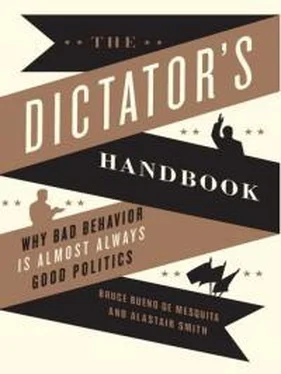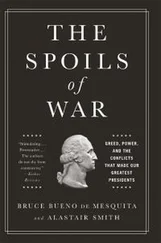Louis’s strategy was to replace the “winning coalition” of essential supporters that he inherited with people he could more readily count on. In place of the old guard he brought up and into the inner circle members of the noblesse de robe and even, in the bureaucracy and especially in the military, some commoners. By expanding the pool of people who could be in the inner circle, he made political survival for those already in that role more competitive. Those who were privileged to be in his winning coalition knew that under the enlarged pool of candidates for such positions, any one of them could easily be replaced if they did not prove sufficiently trustworthy and loyal to the king. That, in turn, meant they could lose their opportunity for wealth, power, and privilege. Few were foolish enough to take such a risk.
Like all leaders, Louis forged a symbiotic relationship with his inner circle. He could not hope to thrive in power without their help, and they could not hope to reap the benefits of their positions without remaining loyal to him. Loyal they were. Louis XIV survived in office for seventy-two years until he died quietly of old age in 1715.
Louis XIV’s experience exemplifies the most fundamental fact of political life. No one rules alone; no one has absolute authority. All that varies is how many backs have to be scratched and how big the supply of backs available for scratching.
Three Political Dimensions
For leaders, the political landscape can be broken down into three groups of people: the nominal selectorate, the real selectorate, and the winning coalition.
The nominal selectorate includes every person who has at least some legal say in choosing their leader. In the United States it is everyone eligible to vote, meaning all citizens aged eighteen and over. Of course, as every citizen of the United States must realize, the right to vote is important, but at the end of the day no individual voter has a lot of say over who leads the country. Members of the nominal selectorate in a universal-franchise democracy have a toe in the political door, but not much more. In that way, the nominal selectorate in the United States or Britain or France doesn’t have much more power than its counterparts, the “voters,” in the old Soviet Union. There, too, all adult citizens had the right to vote, although their choice was generally to say Yes or No to the candidates chosen by the Communist Party rather than to pick among candidates. Still, every adult citizen of the Soviet Union, where voting was mandatory, was a member of the nominal selectorate. The second stratum of politics consists of the real selectorate. This is the group that actually chooses the leader. In today’s China (as in the old Soviet Union), it consists of all voting members of the Communist Party; in Saudi Arabia’s monarchy it is the senior members of the royal family; in Great Britain, the voters backing members of parliament from the majority party. The most important of these groups is the third, the subset of the real selectorate that makes up a winning coalition. These are the people whose support is essential if a leader is to survive in office. In the USSR the winning coalition consisted of a small group of people inside the Communist Party who chose candidates and who controlled policy. Their support was essential to keep the commissars and general secretary in power. These were the folks with the power to overthrow their boss—and he knew it. In the United States the winning coalition is vastly larger. It consists of the minimal number of voters who give the edge to one presidential candidate (or, at the legislative level in each state or district, to a member of the House or Senate) over another. For Louis XIV, the winning coalition was a handful of members of the court, military officers, and senior civil servants without whom a rival could have replaced the king.
Fundamentally, the nominal selectorate is the pool of potential support for a leader; the real selectorate includes those whose support is truly influential; and the winning coalition extends only to those essential supporters without whom the leader would be finished. A simple way to think of these groups is: interchangeables , influentials , and essentials .
In the United States, the voters are the nominal selectorate— interchangeables . As for the real selectorate— influentials —the electors of the electoral college really choose the president (just like the party faithful picked their general secretary back in the USSR), but the electors nowadays are normatively bound to vote the way their state’s voters voted, so they don’t really have much independent clout in practice. In the United States, the nominal selectorate and real selectorate are therefore pretty closely aligned. This is why, even though you’re only one among many voters, interchangeable with others, you still feel like your vote is influential—that it counts and is counted. The winning coalition— essentials —in the United States is the smallest bunch of voters, properly distributed among the states, whose support for a candidate translates into a presidential win in the electoral college. And while the winning coalition (essentials) is a pretty big fraction of the nominal selectorate (interchangeables), it doesn’t have to be even close to a majority of the US population. In fact, given the federal structure of American elections, it’s possible to control the executive and legislative branches of government with as little as about one fifth of the vote, if the votes are really efficiently placed. (Abraham Lincoln was a master at just such voter efficiency.) It is worth observing that the United States has one of the world’s biggest winning coalitions both in absolute numbers and as a proportion of the electorate. But it is not the biggest. Britain’s parliamentary structure requires the prime minister to have the support of a little over 25 percent of the electorate in two-party elections to parliament. That is, the prime minister generally needs at least half the members of parliament to be from her party and for each of them to win half the vote (plus one) in each two-party parliamentary race: half of half of the voters, or one quarter in total. France’s runoff system is even more demanding. Election requires that a candidate win a majority in the final, two-candidate runoff.
Looking elsewhere we see that there can be a vast range in the size of the nominal selectorate, the real selectorate, and the winning coalition. Some places, like North Korea, have a mass nominal selectorate in which everyone gets to vote—it’s a joke, of course—a tiny real selectorate who actually pick their leader, and a winning coalition that surely is no more than maybe a couple of hundred people (if that) and without whom even North Korea’s first leader, Kim Il Sung, could have been reduced to ashes. Other nations, like Saudi Arabia, have a tiny nominal and real selectorate, made up of the royal family and a few crucial merchants and religious leaders. The Saudi winning coalition is perhaps even smaller than North Korea’s.
How does Bell, California, measure up? We saw that in 2009, the interchangeables in Bell consisted of 9,395 registered voters; the influentials, the 2,235 who actually voted; and the essentials, not more than the 473 voters whose support was essential to win a seat on the city council. Bell definitely looks better than North Korea or Saudi Arabia—we’d hope so. It looks alarmingly close, however, to the setup of a regime with mostly phony elections, such as prerevolutionary Egypt, Venezuela, Cambodia, and maybe Russia. Most publicly traded corporations have this structure as well. They have millions of shareholders who are the interchangeables. They have big institutional shareholders and some others who are the influentials. And the essentials are pretty much those who get to pick actual board members and senior management. Bell doesn’t look much like Madison’s or Montesquieu’s idealization of democracy and neither do corporations, regardless of how many shareholders cast proxy ballots.
Читать дальше












